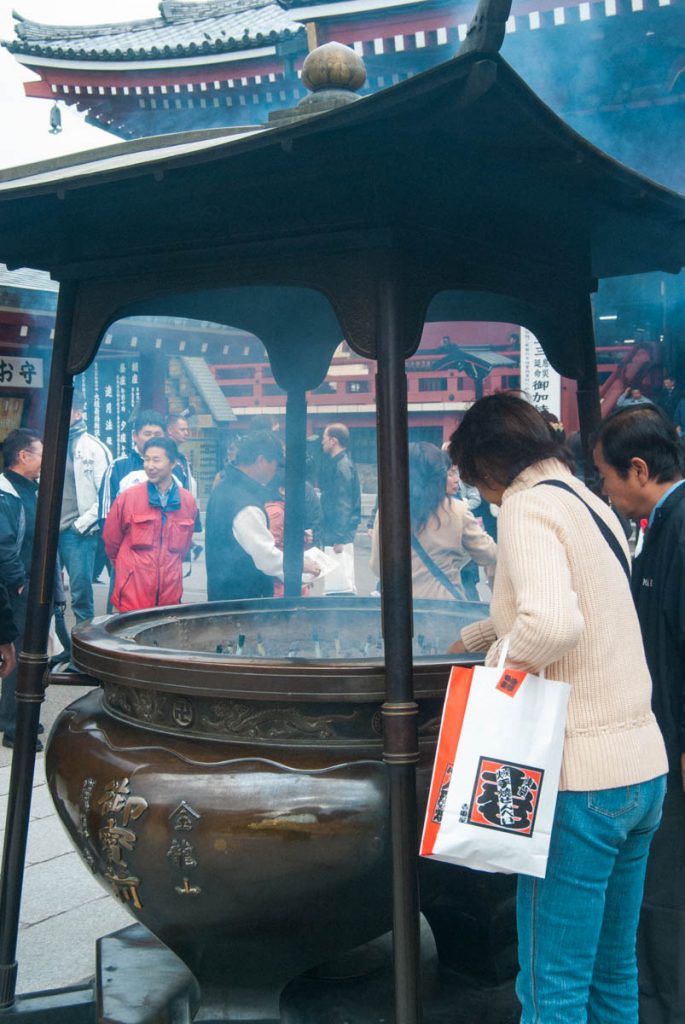Written From… Chicago, Illinois, USA
Senso-ji (金龍山浅草寺) temple is an ancient Buddhist temple in the Asakusa neighborhood of Tokyo, Japan. It is one of Tokyo’s oldest and most significant temples and is a place of tremendous spiritual and secular significance. Visiting the temple in Tokyo is an easy and rewarding trip. In this post we’ll explore the temple’s history, show you how to get there, and share some of the customs and rituals you may observe during a visit.
Senso-ji temple history
Senso-ji Temple, also known as Asakusa Kannon Temple, was completed in AD 645. Legend has it that two brothers fished a statue of Kannon, the Goddess of Mercy, out of the Sumida River. Even though they tried returning the statue to the river, it kept appearing on land. They took this as a sign and began building the temple in her honour.
Various parts of the temple complex were added over time. This includes the outer entrance, known as the Kaminarimon Gate (雷門 or “Thunder Gate”), which was built in the 900s. It was destroyed sometime after this, but restored in the 1600s. The temple complex also contains a five-story pagoda built in AD 924. Various statues to venerated figures including the Buddha were added to the temple over time.
Unfortunately the entire temple complex was destroyed in WWII during the bombing of Tokyo Japan. However, it was rebuilt to its original specifications shortly after the war.
Visiting senso-ji temple
The temple is located in the Asakusa district in Tokyo Japan. Asakusa is known primarily for the Senso-ji Temple, but also for many other religious shrines and statues. The district was originally an entertainment district, housing restaurants and venues for music and theater. Some of that tradition is maintained today: Asakusa is one of the primary districts where restaurants are known for the most authentic and well-known Japanese foods.
Asakusa is easily accessible from the JR Yamanote Line, which encircles the central area of Tokyo. Simply take the Yamanote Line to Kanda Station, then transfer to the Ginza Subway Line for Asakusa. The full trip from Kanda Station is approximately 15 minutes, including transfers. Once you exit the Asakusa Station, the temple is just a few hundred meters away.
When you first approach the temple from the train station, you will see the impressive Kaminarimon Gate, which serves as the entrance to the temple. After passing the gate, you will be in the middle of the Nakamise-dori, a shopping area that is approximately 200 meters long. Here, one can purchase everything from hot foods to trinkets and souvenirs representing Japanese history.

Customs and traditions
As you approach the main temple, you will see two large urns with burning incense sticks. It is believed that exposing oneself to incense clears away evil spirits and cleanses the inner being before entering the temple. Ritual cleansing is an important part of going to any temple in Japan, and when visiting Senso-ji Temple the visitor should take care to observe this ritual out of respect.
After ritual cleansing, the visitor can ascend the stairs into the main hall. Silence is generally observed out of respect for the gods, visitors’ ancestors, and for other visitors. As you approach the heart of the complex, you will see many Japanese throwing coins into a large receptacle.
This is to curry favor with their ancestors, and also to support the ongoing care and maintenance for the complex. After tossing one or more coins, it is common to clap one’s hands three times to summon an ancestor’s spirit, and then to bow in silence offering prayers or requests.
During the time leading up to New Years’ celebrations, many Japanese make special visits to sites like Senso-ji Temple. Many special delicacies and religious items are available at Senso-ji Temple during this period.
As with most other temples in the country, Senso-ji Temple also observes the ritual of joya no kane (除夜の鐘). In this ritual, the main bell at each temple is struck 108 times at midnight on New Year’s Eve. This is said to cleanse the area of evil spirits and ring in an auspicious beginning for the new year.

Opening hours at Senso-ji temple
- The main grounds of the temple complex are always open.
- The main hall is open from 6:00 to 17:30 (opening at 6:30 from October to March).
- The stores on Nakamise-dori are open from 10:00 to 17:00






